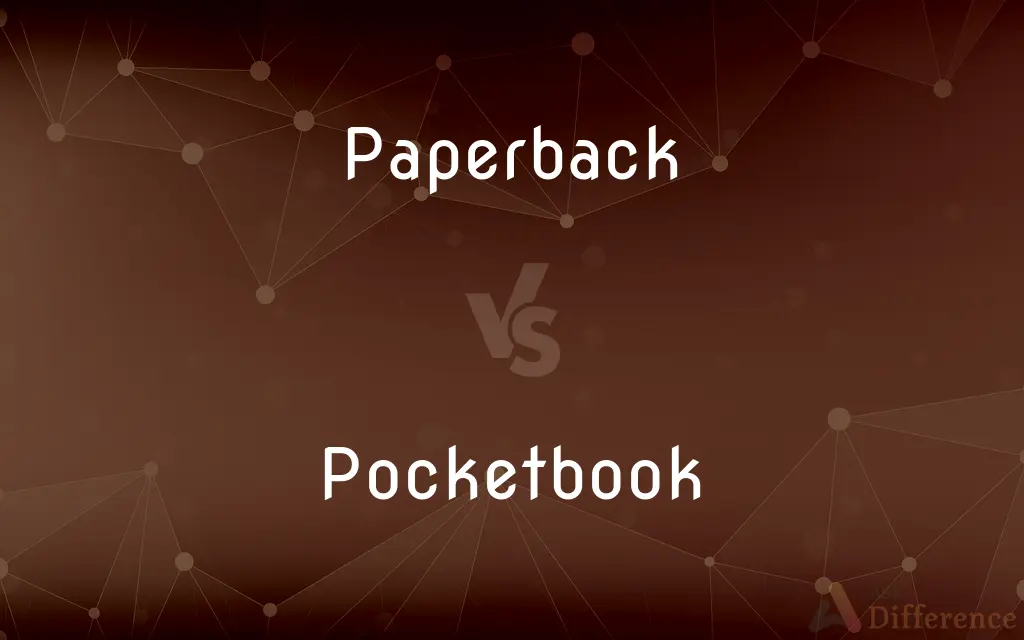Paperback vs. Pocketbook — What's the Difference?
By Maham Liaqat & Fiza Rafique — Updated on March 4, 2024
Paperback books are characterized by their flexible, paper or card covers, while pocketbooks are smaller, portable editions designed to fit in a pocket.

Difference Between Paperback and Pocketbook
Table of Contents
ADVERTISEMENT
Key Differences
Paperback books are defined by their soft covers, made of thick paper or cardstock, which distinguishes them from hardcover editions with rigid, durable covers. Paperbacks offer a more affordable, lightweight option for readers, making literature accessible to a wider audience. They are favored for their convenience and lower production costs, catering to a broad range of genres from fiction to non-fiction. On the other hand, Pocketbooks are a subset of paperbacks, specifically designed to be compact and easily portable. The term "pocketbook" emphasizes the size aspect, suggesting these editions can comfortably fit into a pocket or small bag, ideal for on-the-go reading. Pocketbooks make reading in transit convenient, though their smaller size may lead to a condensed typeface and abbreviated content in some cases.
While all pocketbooks are paperbacks due to their flexible covers, not all paperbacks are pocketbooks because of the size variation. Paperbacks can range in size from large trade paperbacks to the smaller mass-market formats, with pocketbooks typically falling into the smaller end of this spectrum. This size difference means that pocketbooks are specifically tailored for portability, whereas paperbacks as a whole prioritize cost-effectiveness and accessibility over size.
Paperbacks play a crucial role in bringing books to market quickly and affordably, often released after the hardcover edition to reach a broader readership. Conversely, pocketbooks are marketed towards readers looking for convenience and portability, often found in genres that enjoy high circulation like mystery, romance, and thrillers. These smaller editions are particularly popular for casual reading and travel, where space and weight are considerations.
From a reader's perspective, the choice between paperback and pocketbook may depend on their reading habits and preferences. Someone who reads at home may prefer the larger, more comfortable to read paperbacks, while a commuter or traveler might opt for the compactness of a pocketbook. Despite the differences, both formats share the common goal of making reading accessible and enjoyable to as many people as possible.
Comparison Chart
Cover Type
Flexible, paper or cardstock
Flexible, often smaller in size
ADVERTISEMENT
Size
Can vary, generally larger
Compact, designed for portability
Cost
Affordable, more than pocketbooks
Generally more affordable due to size
Portability
Easy to carry, but larger
Highly portable, fits in pockets
Content
Full content, standard typeface
May have condensed content or smaller typeface
Compare with Definitions
Paperback
Affordable edition of literature.
Paperbacks make classic literature accessible.
Pocketbook
Fits in a pocket.
Pocketbooks are perfect for travel.
Paperback
A book with a flexible cover.
The novel was released in paperback form.
Pocketbook
Small, portable book.
She carried a pocketbook for her commute.
Paperback
Popular among casual readers.
Paperbacks are favored for beach reading.
Pocketbook
Compact editions of popular genres.
Pocketbook editions of mystery novels are popular.
Paperback
Wide range of genres.
Bookstores offer a variety of paperbacks.
Pocketbook
Designed for on-the-go reading.
Pocketbooks are convenient for reading anywhere.
Paperback
Released after hardcover.
The bestseller is now available as a paperback.
Pocketbook
May feature condensed content.
Some pocketbooks have abridged versions of longer works.
Paperback
A paperback, also known as a softcover or softback, is a type of book characterized by a thick paper or paperboard cover, and often held together with glue rather than stitches or staples. In contrast, hardcover or hardback books are bound with cardboard covered with cloth, plastic, or leather.
Pocketbook
A pocket-sized folder or case used to hold money and papers; a billfold.
Paperback
A book having a flexible paper binding.
Pocketbook
Often pocket book A pocket-sized, usually paperbound book. Also called pocket edition.
Paperback
A book with flexible binding.
Pocketbook
A pocket-size case for holding papers and paper money
Paperback
To issue or publish (a book) in a paperback edition.
Pocketbook
Pocket-sized paperback book
Paperback
Having a flexible binding; - of books. Contrasted to hardcover or hardbacked or hardbound.
Paperback
A book with paper covers
Common Curiosities
Are pocketbooks cheaper than paperbacks?
Yes, due to their smaller size, pocketbooks are often cheaper to produce and purchase.
Can all books be found in pocketbook format?
Not all books are available in pocketbook format; it's more common for popular genres and titles.
What is the main difference between a paperback and a pocketbook?
The main difference lies in size and portability; pocketbooks are smaller and designed to be easily carried, while paperbacks are generally larger.
Is the content in pocketbooks the same as in paperbacks?
While the content is generally the same, some pocketbooks may have condensed content or smaller typefaces to fit the compact size.
Do pocketbooks have illustrations and graphics like paperbacks?
They can, but illustrations and graphics may be smaller or fewer in number due to size constraints.
Are pocketbooks and mass-market paperbacks the same?
Pocketbooks are a type of mass-market paperback, specifically noted for their compact size.
How do I choose between a paperback and a pocketbook?
Your choice might depend on where and how you plan to read the book; consider portability and ease of reading.
Why might someone prefer a paperback over a pocketbook?
Readers may prefer paperbacks for their larger size, which can make for a more comfortable reading experience.
Can I find academic texts in pocketbook format?
It's less common, as academic texts often require larger formats for detailed content and illustrations.
Is the quality of paper the same in paperbacks and pocketbooks?
The paper quality can vary, but both formats typically use paper that is durable yet affordable.
What is the future of pocketbooks and paperbacks in the digital age?
Despite digital alternatives, pocketbooks and paperbacks remain popular for their convenience, affordability, and tactile reading experience.
Why are paperbacks released after hardcovers?
Paperbacks are often released after to reach a broader audience with a more affordable option following the initial hardcover release.
Are pocketbooks environmentally friendly?
Their smaller size can reduce material use, but environmental impact depends on production practices.
How do publishers decide which books to release as pocketbooks?
Publishers consider factors like genre popularity, portability demand, and market trends.
Can I find new releases as pocketbooks?
New releases may be available as pocketbooks, especially in popular genres.
Share Your Discovery

Previous Comparison
Mislead vs. Misguide
Next Comparison
Norovirus vs. RotavirusAuthor Spotlight
Written by
Maham LiaqatCo-written by
Fiza RafiqueFiza Rafique is a skilled content writer at AskDifference.com, where she meticulously refines and enhances written pieces. Drawing from her vast editorial expertise, Fiza ensures clarity, accuracy, and precision in every article. Passionate about language, she continually seeks to elevate the quality of content for readers worldwide.















































